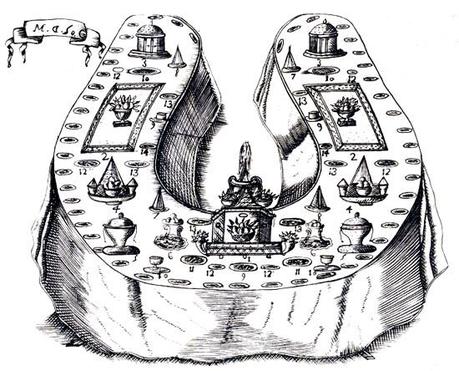One menu item that has made many diners happy in the 21st century is the emergence of the dessert degustation. If I see one listed, I order it so I don’t have to make any difficult choices like panna cotta or citrus tart, or chocolate fondant, or baked figs, or the lot… And usually, the servings of each item aren’t too large so I don’t end up overdosing on chocolate.
The dessert degustation is really nothing new. Dessert chefs down the centuries have showcased their talents with many magnificent structures. Hours have been spent toiling over sculpted sugar fantasies, towers of sweetmeats and other calorific edifices. In modern times these were scaled down to dessert trolleys, still groaning with options for the often already sated diner.
One elaborate affair from the 18th century has been preserved on paper for later generations. It was the brainchild of Juan de la Mata, who served as dessert chef to Philip V and Ferdinand VI of Spain and who published his cookbook Arte de repostería (Art of Pastry) in 1747.
Picture this – a horseshoe shaped table with 50 place settings round the outer side. All the serving is done from within the horseshoe so the dinner guests won’t be disturbed.
At the bottom of the horseshoe is a fountain. This is fed from a main tank hidden in the roof or in a nearby wall, through a tin pipe hidden under the table. The fountain is equipped with a large basin surrounded by herbs, flowers and sugar figures, carefully placed so they don’t get wet.
Another concealed pipe conveys the liquid from the fountain into a tub or skin under the table and this is carried back to the main tank so the fountain does not stop flowing.
The fountain could contain milk, wine or water. Water was no doubt the most practical but wine would have been a nice touch.
The mind boggles a little at the likely antics under the table as staff fetched the liquid for recycling.

Juan de la Mata's dessert spread plan for 50 seated guests with the fountain taking pride of place in the front.
But the dessert chef proposed plenty of visual distractions on top of the table. These are numbered in the illustration and included:
- The fountain itself
- Four table pieces done as gardens, with sugar figures and flowers
- Two dome-topped pavilions or belvederes with four doors, their stairways decorated with various sugar figures, flowers, and sweets, and a figure on top of each one
- Four sugar paste pyramids of different colours, some candied oranges, and the rest featuring all kinds of sweets and flowers
- Two Chinese jars, one with custard and the other with cow’s milk curds
- Two dishes, one with rolled wafers, and one with flat glazed or ruffled wafers
- Two pyramids of cooked cream, with egg whites and cow’s butter
- Two more pyramids of chilled red fruit
- Three dishes of cheese from ass’s milk
- Four platters of fruits, chilled and raw, intermingled.
- Four further platters: two at the head, and two in the middle, holding a range of Savoy and other cakes
- Six dishes of different compotes
- Six more platters of green fruits of all types, garnished with leaves
- Four platters of chilled cheeses, two at the head of the table, and two in the middle of the table flanks
Wasn’t that a dainty array to set before the king and his guests?
De la Mata was a disciple of the French and Italian culinary schools and in his book he offered many popular recipes of the 18th century, explained step by step and in detail, for preparing all sorts of sweets, pastries, jams, jellies, jams, preserves, cakes, marzipan, meringue, doughnuts, candies, chocolates and ice cream.
He gave practical tips and warnings about utensils needed in every kitchen, the pastry techniques and the most appropriate way to provide and serve a table holding a large number of guests.

